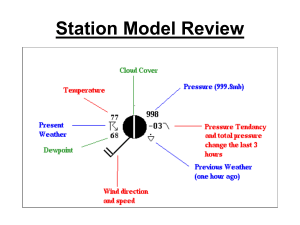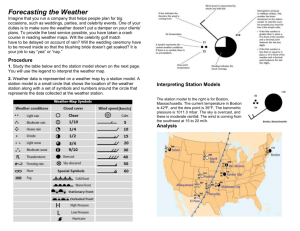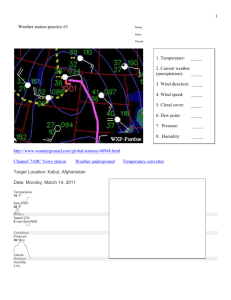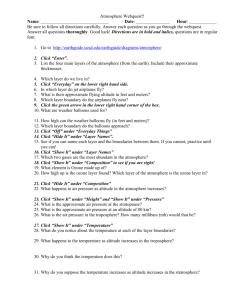A Solution to the Dew Paradox
advertisement
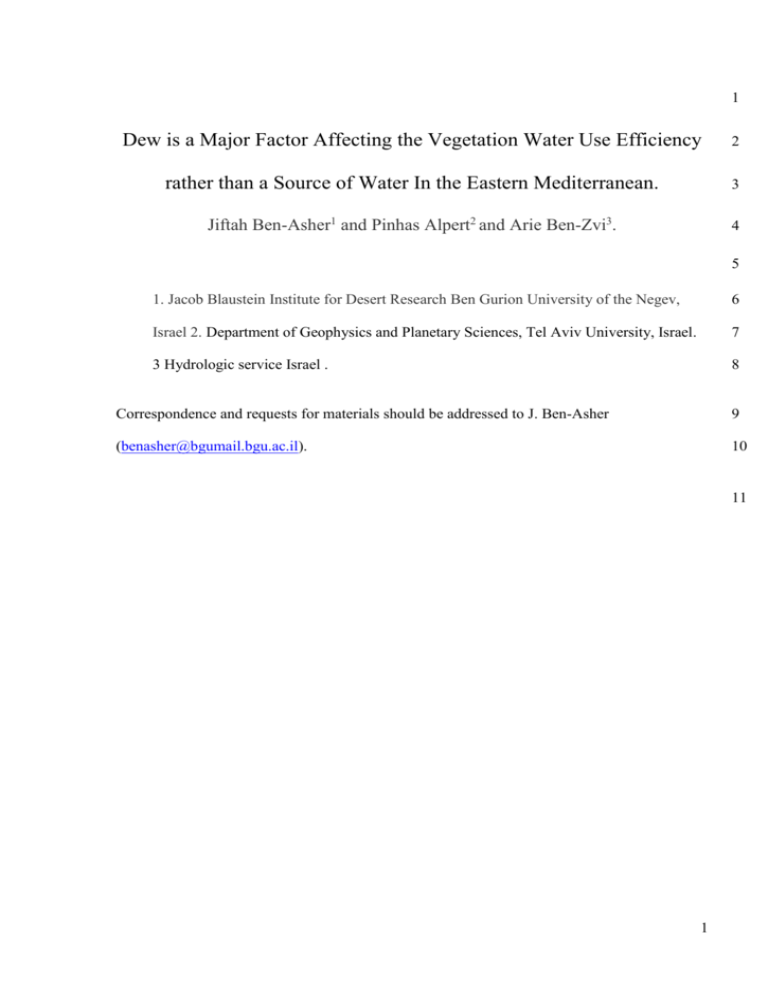
1 Dew is a Major Factor Affecting the Vegetation Water Use Efficiency 2 rather than a Source of Water In the Eastern Mediterranean. 3 Jiftah Ben-Asher1 and Pinhas Alpert2 and Arie Ben-Zvi3. 4 5 1. Jacob Blaustein Institute for Desert Research Ben Gurion University of the Negev, 6 Israel 2. Department of Geophysics and Planetary Sciences, Tel Aviv University, Israel. 7 3 Hydrologic service Israel . 8 Correspondence and requests for materials should be addressed to J. Ben-Asher 9 (benasher@bgumail.bgu.ac.il). 10 11 1 Abstract 12 The purpose here is to re-examine the ecological importance of dew in arid and semi arid 13 regions with a focus over the eastern Mediterranean. This re-evaluation is of particular 14 importance under the controversial perspective that dew is insufficient as a source of water to 15 plants but it is sufficient to promote the spread of plant diseases . Adana, Turkey was selected 16 as an appropriate semi arid test ground with well documented meteorological data and a newly 17 developed photosynthesis (Pn) and transipiration rate (Tr) monitor (PTM) which was used to 18 detect the response of Tr and Pn to the presence of dew on the leaves. A convolution 19 theoretical model was used to simulate “no dew” days and simultaneously PTM measurements 20 were used to obtain actual situations with “dew”. Contrary to expectations we detected 21 separated, early peaks of Pn and late peaks of Tr . It led to average ratio of about 2:1 units of 22 water use efficiency (WUE) for "dew" affected versus "no dew" conditions. The integrated 23 effect over a day showed that dew improved WUE by 20-40%. The impressive performance of 24 the dew affected WUE was explained by a synergy between a) low transpiration during dew 25 affected morning hours and b) high CO2 gradient toward the canopy. The first resulted from 26 dew formation that created humid environment at the near vicinity of the leaf followed by low 27 leaf to air vapor pressure deficit ( VPD). It minimized transpiration while maintaining optimal 28 stomatal conductance. The second resulted from night respiration that induced high CO2 29 gradient from the air toward the canopy. This synergy resulted in an intensive carbon intake 30 at a low water cost and explained the ecological importance of dew . 31 Introduction 32 The controversial perspective: dew as a major ecological factor. 33 Modern science has shown that the amount of water from dew for plant water budgets is 34 negligible, but that it is sufficient to promote the spread of plant disease. It is for this reason 35 2 that dew has been recently described mainly as a source of inspiration for poets rather than as 36 something beneficial for plants. In contrast, in ancient time dew was believed to be a source of 37 great blessing. Pioneering dew research in the late 1950's, early 1960's emphasized the 38 inspiration of dew upon poets as opposed to its impact on plant water status [Monteith, 1963; 39 Montieth, 1957]. These quantitative studies criticized the descriptive studies on dew with 40 sentences including: "every poet who has sung the beauties of Nature has added his tribute to 41 the sparkling dew drops…and ecological investigations of dew have strayed into description 42 which belong to poetry". The new studies found that for purely physical reasons dew is 43 unlikely to support the water budget of plants since the ratio of potential condensation to 44 potential evaporation is roughly 1:7 in humid climate and 1:14 in arid climate. This was 45 further supported by measurements of dewfall in the Negev desert of Israel showing that 46 maximum total dewfalls do not exceed 0.2 mm per day in any case, whereas actual evaporation 47 of about 5-6 mm per day is not uncommon. Other reports counted 100-200 dew nights which 48 amounted to 50-100 mm per year[Zangvil 1996; Goldreish 2003; Jacobs, et al. 2006]. Today, 49 the role of dew cited is mostly negative. Plant pathologists emphasize the negative role played 50 by dew in the promotion of plant diseases [ Santos et al 2008; Jacobs et al. 2006]. The entry 51 in Encyclopedia Britannica reads :”From the biological viewpoint, the usefulness of dew is 52 doubtful, as dew may stimulate the growth of fungi harmful to plants [Encyclopedia Britannica 53 2007]. Another research states, "Dew plays an important role in the propagation of certain 54 plant pathogens [Huschke 1991]." Amazingly nothing is mentioned about the benefit of dew to 55 the plant water regime. 56 On these grounds it has been argued that the contribution of dew to the overall vegetation 57 water regime is negligible. Current dew research is dominated by phytopathologists who are 58 concerned with the calculation of leaf wetness duration that is related to plant disease 59 3 occurrence [Sentelhas et al 2008] and plant protection against the negative role played by the 60 dew in the promotion of plant diseases. 61 Contrary to the above we found that dew formation serves as an integral part in the general 62 strategy of vegetation water economy in the arid and semi arid zones. The significant 63 contribution of dew to the plant water economy will be explained and demonstrated hereafter. 64 Materials and Methods 65 A field study was carried out in the Chukurova basin near Adana Turkey (~ 37° 01' N, 66 35° 21' E; elevation 10-150 m). This site was selected as an appropriate test ground after 67 thorough analysis of meteorological data [Kimura et al. 2007; Kitoh 2007] from 1994 to 2003 68 showed that every summer, throughout 330±70 hours the dew point temperature was larger or 69 equal to the air temperature, and the relative humidity during these hours varied between 99 70 and 100%, thus satisfying the necessary conditions for dew formation. The basin is situated in 71 the Mediterranean region surrounded by the Taurus Mountains. The Mediterranean climate is 72 hot and dry in summers and mild and rainy in winters. 73 The experimental approach 74 Meteorological measurements: Over a period of 5 days, we measured and calculated the 75 relevant meteorological variables including:PIR-1, a Photosynthesis Radiation Sensor which 76 measured photosynthesis photon flux desity (PPFD). The ATH measured ambient temperature 77 and relative humidity from which Vapor Pressure Deficit ( VPD) and Dew Point Temperature 78 (DPT) were determined using one of the dew point calculators 79 (http://www.decatur.de/javascript/dew/index.html) when relative humidity (RH) was at its 80 maximum. The measured DPT and associated climatic conditions are given in table 1 81 Table 1 82 . Within the Chukurova basin maximal relative humidity (RH), ranged between 93 and 99% 83 and on the Taurus Mountains it was about 10% less. Minimal ambient temperature varied 84 4 between 21 and 23°C and minimal leaf temperarures varied between 19 and 21°C. Dew was 85 formed when DPT was lower than leaf temperature. In the early morning hours canopy 86 temperature was below the DPT of the surrounding air and leaves were covered with dew in 87 four nights on three crops. Dew formation was not detected when leaf temperature was slightly 88 higher than the DPT. 89 Plant physiological measurements: The measurements of photosynthesis and transpiration 90 were taken with PTM-48. Photosynthesis and Transpiration Monitor[ Bio Instruments 2007]. 91 The combined measurements of leaf temperature that was measured with LT sensors.and RH 92 enabled the monitor's software to determine the leaf to air VPD. Photosynthesis and 93 transpiration data from the leaf chambers as well as data from the additional sensors were 94 automatically recorded every 30 min around-the-clock. Considering Fick's first law the leaf 95 conductance was obtained from the ratio: gl = TR/ VPD (TR units) .With (gl) leaf hydraulic 96 conductance which is a coefficient of proportionality between transpiration flux density 97 (converted to H2O volumes area-1 time-1) and its driving force VPD in terms of partial vapor 98 pressure[Alessio et al.2004]. 99 The PTM : This is a new portable device equipped with a four-channel automated system for 100 monitoring CO2 exchange and transpiration of leaves. Each of the four chambers is a self- 101 clamping leaf chambers, which operate one-by-one in such a manner that one of the leaf 102 chambers is closed at a time while all others remain open. Thus, most of time, the sample 103 leaves are not disturbed. The CO2 exchange is determined by decrement of CO2 concentration 104 at the outlet of the leaf chamber, which is compared with the concentration of incoming 105 ambient air . Transpiration rate is determined in much the same way using the absolute 106 concentration of water vapor in the air. To shorten the measurement cycle, the absolute 107 humidity is computed during a transient period between 20th and 30th second after closing the 108 chamber. The calculation algorithm takes into account the rising humidity inside the chamber 109 5 and, hence, allows determining the initial transpiration rate at the ambient air humidity. Note 110 that the PTM provides unique capability of continuous measurement of undisturbed gas 111 exchanged of a single leaf . Other available devices for measurements of leaf gas exchans are 112 capable of manual sampling and hence require special efforts and arrangements to observe the 113 early morning dew formation ( as opposed to monitoring ) whereas the PTM provides 114 automated long-term monitoring of fluxes at the leaf levels. Additional details on the PTM and 115 the organization of the records were given by Ben Asher et al.( 2008). It should be mentioned 116 here that eddy covariance is another useful method for simultaneous monitoring of PN and TR 117 (Mildenberger et al. 2009) but unlike the ordinary diffusion theory the diffusion coefficients of 118 H2O and CO2 are the same. In the eddy covariance theory a small packet of air moves more or 119 less as a unit carrying with it all the H2O and the CO2 molecules that it contains and hence 120 separation between PN and TR under "dew" and "no dew" conditions are not possible. 121 Soils variables : Only three (out of the four) leaf chambers were use to monitor leaf gas 122 exchange. The forth chamber was used to monitor soil respiration . Three soil moisture Sensors 123 (TDR= Time Domain Reflectometry ) were used to determine the water content as a 124 suplamental data. These supporting sensors were used to compare soil water contents and soil 125 respiration of the irrigated crops and the non irrigated natural vegetation in order to 126 characterize the differences between the two habitats. . 127 Crops and Mediterranean vegetation: The field crops were: Cotton (Gossypium 128 hirsutum) , Soybean (Glycine max), and Maize (Zea mays) , One orchard plantation Lemon 129 (Citrus limon) was studied and a groupe of natural Mediterranean vegetation spicies: Pine 130 ( Pinus pinea), Pistachio (Pistacia terebinthus) and Oak ( Phyllyrea media . This group was 131 located on the slope of the Taurus mountins elvated some 150 m. above sea level. 132 Measurements conducted from June 16 to June 22 2003 and a summary of important data is 133 given in table 1 . 134 6 Table 1. 135 Each day another crop was equipped with the measuring system for at least 24 hours with the 136 hope to detect dew formation. In the nights of June16-19 the dew point temperature was 137 higher than the leaf temperature and dew was detected on the leaves. In the nights of 20 and 21 138 the dew point temperature was smaller than the leaf temperature and dew was not formed. 139 Data analysis :First we should emphasize that there is low probability to find a day in which 140 two fields of the same crop and environmental conditions differ from one another only by the 141 presence of dew . Thus, simple comparison between crops response to "dew" and "no dew" 142 conditions is impossible "de facto". In order to overcome this problem we characterized leaves 143 properties by two empirical dimensionless parameters: " unit photosynthesis" and "unit 144 transpiration". It was assumed that CO2 uptake is accompanied by water efflux through the 145 stomata and both are generated only by PPFD. Consequently, proportions of transpiration 146 and photosynthesis change diurnally in concert with PPFD. Another generality that will be 147 discussed in more detailes in the theory section, is that unlike dew affected leaves in dry leaves 148 the two processes are linked linearly to PPFD. Thus, to separate “dew” from “no-dew” 149 conditions we developed a convolution model that was based on empirical data. solved it in 150 Excel (Olsthoorn 2008) and represented the “no dew” situation during the daylight hours. . 151 Statistical considerations: 152 The diurnal evolution of transpiration and photosynthesis of the different plants was unified by 153 presenting the measured values in terms relative to the maximum fluxes. We presented the 154 data in relative term because it allows to combine many values and processes in a concise 155 manner and representation of a large group in this way is easier to comprehend than a large 156 mass of actual data . Furthermore, the diurnal evolution of gas exchange can be extracted for 157 each crop from the product of maximum fluxes and the relative value at any given time. . 158 The maximum fluxes of cotton corn and soybean are given in table 2. 159 7 Table 2 160 161 The dimensionless data are thus an average of actual values from three dew affected plants 162 with three replications such that each data point represent a population of 9 plants. The 163 standard deviation (s.d.) of ambient CO2 was determined with four probes. Average s.d. of 164 the normalized values was 0.13 for both photosynthesis and transpiration. 165 Results and discussion 166 Experimental observations 167 The results in Fig. 1A display the lag time between peak Pn and peak Tr of the dew affected 168 crops ( 3 crops with 3 replications n=9, 1 standard deviation, s.d. = 0.13). From Fig.1A , 169 maximum photosynthetic rates were measured several hours earlier than maximum Tr rate. 170 Fig 1B shows the same trend with actual fluxes of H2O and CO2 for cotton leaves 171 Fig. 1 172 8 1.2 DIMENSIONLESS FLUX 1.0 0.8 0.6 0.4 0.2 PHOTOSYNTHESIS (mol m-2s-1) -0.2 20 6 Photosynthesis Transpiration 5 15 4 10 3 5 2 0 1 -5 TRANSPIRATION (mmol m-2s-1) 0.0 0 0 5 10 15 20 25 TIME OF THE DAY 173 Fig. 1. The effect of dew formation on the diurnal course of Pn and Tr. (A) Normalized values 174 for the three dew affected plants: Cotton, Maize and Soybean . (B) Example of actual data for 175 cotton. Pn scale is given on the left ordinate. Tr scale is given on the right ordinate. The double 176 arrow line indicates 9:00am at which the largest difference and ratio between Pn and Tr was 177 obtained. It thus indicates the time of maximum WUE. 178 179 180 181 Separated, early peaks of Pn and late peaks of Tr are contrary to expectations because the 182 pathway for diffusion of CO2 into leaves is similar to the pathway for diffusion of H2O out of 183 leaves. Both are strongly linked to stomatal conductance and solar radiation. Thus the two 184 9 processes are expected to be in the same phase. [Collatz et al.1991;Fritschen 1973; Slatyer 185 1960;de Wit 1978; Pollard and Thompson 1995, Nobel 2005]. 186 In Fig 1 however, Pn in the early morning hours was weakly linked to Tr or not linked at all. 187 We argue here, and later demonstrate it experimentally that, thanks to the dew, this weak 188 linkage is an inherent part of a strategy aimed at maximizing WUE which is most important in 189 habitats where water supply is limited. The presence of dew on the leaves creates temporary 190 humid conditions in the leaf-air boundaries , followed by a reduction of the driving force for Tr 191 thus increasing stomata aperture [Jarvis et al. 1999; Monteith 1995; Mott and Parkhurst 192 1991]. The biophysical basis for the results is shown in Fig 2 that presents the stomatal 193 conductance resulting in response to low Tr in the morning (Fig 1). Concurrently , high Tr at 194 noon time resulted in low canopy conductance. This result was explained theoretically by a 195 reanalysis of the stomata response (Monteith 1995). The conclusion of this reanalysis was that 196 stomatal conductance and the equivalent canopy conductance (g) respond to the rate of Tr 197 rather than to humidity per se. In general, dg/dTr is negative. That is when dew covers the 198 leaves the hydraulic conductivity of the canopy, is high and at noon when Tr is at its peak the 199 hydraulic conductivity is low. 200 Fig. 2 201 10 1.0 A 0.8 CANOPY CONDUCTANCE (Dimless) 0.6 0.4 0.2 0.0 Dew affected conductance Y=0.154X-0.6; r2=0.88 Unaffected conductance ; Y=0.135X-0.6 ;r2=0.88 2=0.92 -0.2 4 5 6 7 8 9 10 TIME OF THE DAY 60 B 50 (mm hr-1) 40 30 20 10 0 0 5 10 15 20 25 TIME OF THE DAY 202 Fig.2 The effect of dew formation on the course of canopy conductance. A) Zoom on the early 203 morning average of normalized canopy conductance of “dew” “no dew” plants (1s.d.=0.36). 204 B) Example of actual data and the standard deviation for cotton. The solid straight lines show 205 the linear correlations of “dew”and “no-dew” conductance as a function of time from 4 to 206 9:30am. 207 In Fig. 2A it is most important to note that canopy conductance during the most effective 208 photosynthetic hours, with dew in the morning, was about 2.5 times larger than that in the 209 afternoon, when peak Tr occurs. At 9:00am it was about 1.5 times larger than the plants 210 without dew. It resulted from the presence of dew on the leaves which caused a temporary 211 11 reduction in VPD associated with relatively high stomatal conductance. Fig. 2B is the actual 212 canopy conductance of cotton. As an example of its diurnal cycle it shows typical bimodal 213 midday depression in the cotton field. The main peak in the morning is affected by the dew. 214 Then it displays the midday depression and a second small peak in the afternoon that is 215 unaffected by the dew. 216 In terms of the molecular diffusion equations(Fick's first law ), any increase in canopy 217 conductance will cause a linear increase in the assimilation rate of CO2 . Thanks to the dew, Tr 218 will not increase in proportion because, stomata are open early in the morning when water 219 vapor gradient is minimal and the evaporative ability of the atmosphere is also small. Moreover, 220 as shown in Fig.3, night respiration increased, dramatically , CO2 concentration in the air 221 Fig 3 222 550 1=Mature corn 2=Young cotton and soy bean 3. Natural Mediterranean vegetation CO2(ppm) 500 450 1 400 350 2 3 300 0 5 10 TIME 15 20 Fig.3 The effect of night respiration on the diurnal course of CO2 concentration in the air. 223 224 Lines are the moving average of four sampling channels. An example of actual data and their 225 standard deviation of the average is shown for the mature corn. 226 227 12 (For example within the corn field, from 320 to 460 ppm). During these hours the CO2 228 gradient is at its maximum. Thus, with high potential for CO2 intake and low potential for Tr 229 each unit of fixed CO2 costs less water. The difference between Mediterranean vegetation and 230 cultivated crops was studied by Evrendilek et al. [2008] who concluded that net ecosystem 231 emission (NEE) increased as Pn decreased, and soil respiratory loss of CO2 to the atmosphere 232 increased. Our measurements indicated that soil respiration was the dominant contributor to 233 NEE. Soil respiration of the Mediterranean vegetation was only about 20 µmol m-2 s-1 while 234 that of the cultivated crop reached 40 µmol m-2 s-1. Thus, the natural vegetation suppressed 235 the contribution of Mediterranean ecosystems to NEE as shown in Fig 3. 236 Modeling the "no dew " conditions. 237 I. Biophysical consideration: 238 The usual case which causes a loss of water from the leaf during daylight hours (from late 239 morning to early afternoon) requires the vapor pressure of the leaf to be greater than is in the 240 surrounding air and the stomata is opened. However in the early morning hours when vapor 241 pressure in the air is greater than that in the leaf then a net diffusion of water vapor occurs 242 toward the leaf. This can increase the vapor pressure at the leaf surface to saturation value and 243 form dew or even intake of water into the leaf. Stomata control the exit of water vapor from 244 leaves and the entry of CO2 into them. Upon illumination stomata is open through a well 245 known (Nobel 2005 ) set of biophysical process. In the usual case above, stomata opening 246 leading to the CO2 intake that is necessary for photosynthesis, result in an inevitable loss of 247 water for which the driving force is the availability of irradiative energy. Our results (Fig 4 ) 248 corroborated with many others ( for example Mildenberger et al. 2009) and showed that 249 during a "no dew" testing day the transpiration and photosynthesis started at sunrise and both 250 reached the sinusoidal peak shortly after the peak of the PPFD. 251 Fig 4 252 13 2000 PPFD(mol m-2 s-1) 6 Photosynthesis Transpiration PPFD PPFD 5 1500 4 1000 3 2 500 1 0 0 0 4 8 12 16 20 PHOTOSYNTHESIS (mol m-2 s-1) -2 -1 TRANSPIRATION (mmol m s ) 253 24 TIME OF THE DAY 254 Fig 4. The course of PPFD transpiration and photosynthesis in Lemon. Measurements were 255 taken under "no dew " conditions to demonstrate the signal (PPFD)that results in a 256 simultaneous and linear response in gas exchange ( CO2 and H2O) as opposed to the above 257 (Fig.1 ) "dew" conditions. . 258 In figure 4 photosynthesis and transpiration responded linearly to changes in PPFD with a 259 correlation coefficient r2=0.72 and 0.86 for transpiration and photosynthesis respectively. The 260 linearity of "no dew" behavior suggest that the growth rate of CO2 fixation by the leaves and 261 transpiration from the leaves is large when PPFD is large at least over a significant part of its 262 range . Moreover this linearity means that the flow of the CO2 and H2O is independent of one 263 another. The importance of this last consequence is that each of the two components is 264 affected by its own concentration gradient. For example the concentration and the gradient of 265 CO2 and hence the photosynthetic flux is not affected by the dew. Thus, when modeling it as a 266 14 function of PPFD the model is a "no dew" model. One way to describe such behavior is with 267 the convolution type of expression that will be given in the mathematical consideration. 268 II. Mathematical consideration: 269 Convolution is a form of superposition that efficiently deals with input varying arbitrarily in 270 time or space. PPFD in this case is the energy input that varies with time. Even though 271 convolution is well-known since the 19th century, to our knowledge the method was not used 272 extensively or not used at all in micrometeorology. It works whenever superposition is 273 applicable, that is, for linear systems. As shown above in "no dew " systems photosynthesis 274 and transpiration are the impulses that responded linearly to the pulse of energy input (PPFD). 275 This linearity implies that the response of photosynthesis and transpiration to PPFD is 276 unique and it has a unique "unit step" response. This unit step response contains all the 277 dynamic information of the system but dew is not included because, as was previously stated 278 the calculated photosynthetic flux is affected linearly by PPFD and "dew" do not take part in 279 the calculated process. For this reason we provided the convolution model as an indication for 280 "no dew " conditions to compare with the actual measurements during the "dew" hours when 281 dew is effective. 282 The development of the convolution model was based on actual sets of continuous 283 measurements of photosynthesis and transpiration and PPFD as a driving force. We extracted 284 "unit steps" response which were marked : UTr for unit transpiration and UPn for unit 285 photosynthesis using the practice of deconvolution 286 A simple way to express the convolution that was carried out in the study is in a matrix form: 287 [Tr] = [PPFD][UTr] [1a] 288 [Pn] = [PPFD][UPn] [1b] 289 Where UTr and UPn are matrices of dimensionless units of Pn and Tr that are produced by 290 one unit of PPFD. 291 15 Equation [1] is a discrete convolution equation and following the biophysical considerations , it 292 allows the computation of Tr and Pn without dew. Given PPFD, UTr and UPn the unknown 293 unit transpiration and photosynthesis (UTr and UPn) were determined by the reverse process 294 (deconvolution), from the ratios: [Pn]/[PPFD] and [Tr]/[PPDF]. 295 This was needed in order to derive continuous processes of transpiration and 296 photosynthesis that are strongly affected by PPFD and less or not affected by dew formation. 297 We now have two expressions for WUE: 298 WUEWD=Pn(t)/Tr(t) [ 2a] 299 WUEWOD = [PPFD][UPn]/ [PPFD][UTr] [2b] 300 where the subscripts of the WUE are with dew (WD) and without dew (WOD) 301 III Using measured and convoluted WUE for comparison of "dew" and "no dew" 302 conditions 303 The results of calculated WUE are displayed in Fig.5. 304 Fig.5 305 306 16 0.014 0.010 0.010 0.008 0.008 0.006 0.006 0.004 0.004 0.002 0.002 0.000 0.014 Maize WD Maize WOD 0.012 0.010 0.008 0.006 0.004 0.002 0.000 0.014 0.000 0.014 Pistacio WD Pistacio WOD 0.012 0.010 0.008 0.006 0.004 0.002 0.000 0.014 Cotton WD Cotton WOD 0.012 Lemon WD Lemon WOD 0.012 WATER USE EFFICIENCY (mol/mmol) WATER USE EFFICIENCY (mol/mmol) 0.014 Soybean WD Soybean WOD 0.012 Oak WD Oak WOD 0.012 0.010 0.010 0.008 0.008 0.006 0.006 0.004 0.004 0.002 0.002 0.000 0.000 6 8 10 12 14 DAY LIGHT TIME 16 18 6 8 10 12 14 16 18 307 DAY LIGHT TIME Fig.5 The course of WUE during daylight hours. The “dew” affected lines (marked with WD ) 308 are results of measurements while the “no dew ” lines (marked with WOD) resulted from the 309 convolution model. Note that measurements of WUE on the right hand side of Fig.5 were taken 310 under “no dew” conditions as specified in table1, but are included in the text as “dew” in order 311 to make a consistent distinction between measured and convoluted lines. 312 On the left side of Fig.5, WUE that was affected by dew and obtained from the actual 313 measurements ( Eq.2a) is compared to the ratio that was convoluted ( Eq.2b )and linked to 314 PPDF with a weak or no affect of dew . Clearly until late morning WUE with “dew” based on 315 actual data ranged between 0.010 and 0.014 WUE units while WUE in the afternoon it was 316 about one order of magnitude smaller and ranged between 0.002 and 0.004 . It can also be seen 317 that the afternoon values of WUEWD were very close to the low WUEWOD of the simulated “no 318 dew” conditions. On the right hand side of Fig. 5 the actual measurements of WUEWD (Eq. 319 17 2a) were practically the same as the modeled value (WUEWOD in Eq. 2b) throughout the entire 320 day and they ranged between 0.0 and 0.004. This result emphasizes the situation when the 321 major factor affecting WUE is solar radiation ( in its PPFD form ) and not the presence of 322 dew. Here both the measured and the simulated WUE with “no dew “ conditions are lower than 323 that on the left hand side when dew was a dominant factor affecting WUE. 324 The strength of this convolution analysis is in its ability to approximate properly what would 325 be the WUE under "no dew " conditions. It was formulated in order to demonstrate the 326 difference between WUEWD and WUEWOD and as such it strengthen the experimental data 327 obtained from a large group of plants and crops which suggested that the presence of dew 328 improved water use efficiency. 329 330 Concluding comments and related issues. 331 Modern growers and ecologists with sharp senses to natural phenomena detected the blessings 332 of dew. In biblical times also the dew blessing was considered to be similar or even to a larger 333 extent as compared to rainfall but without proper scientific documentation (Monteith 334 1957,1963). Our study with modern instrumentation provides for the first time, the 335 experimental picture as to the interaction between dew and plant growth, illustrating how the 336 dew plays an important role in biomass production at low water cost. Moreover, the 337 consequences of this study are independent of the dispute regarding the role of dew as a water 338 source. On one hand preliminary estimations based on global warming output suggest 339 reductions in the dew frequencies with a potential significant effect on the WUE; a fact not 340 considered yet in the vast literature on global warming impacts. Prediction of regional warming 341 [Kimura et al. 2007;Kitoh 2007] for the years 2070-2080 indicated a clear decline of relative 342 humidity in the region from 100% down to 64±18% during the best hours for dew formation 343 in the summer. If the predicted regional warming of the eastern Mediterranean becomes a 344 reality, natural vegetation and agricultural crop will likely display reductions in WUE and 345 increase in water demand in order to maintain the current biomass production. On the other 346 18 hand elevated CO2 may result in significant increase of plant growth. Prediction of the impact 347 of these two contradicting directions requires a more comprehensive model that is currently 348 under study and a different set of measurements. It can possibly be obtained by the 349 approximated relationship (Kefi et al 2008) WUE ≈ Atmospheric CO2 concentration /VPD. As 350 a first approximation our convolution model assumed that the major and the only driving force 351 for Pn and Tr is the PPFD. Under this assumption, atmospheric CO2 concentration does not 352 significantly affect the two functions. According to this approximation the response of the 353 stomata to the environmental conditions in its near vicinity is hidden within the UPn which 354 provides the photosynthetic rate per unit PPFD and the UTr which provides the transpiration 355 rate per unit PPFD. 356 1. 357 AcknowledgementsThis study was funded by the Gerda Freiberg chair for Agricultural water 358 management. BGU,, grant from ministry of Science Israel and 359 the Bundesministerium fuer Bildung und Forschung> (BMBF) ,The ICCAP project ( Impact of 360 Climate Change on Agriculture Productivity of the Research Institute for Humanity and Nature 361 (RIHN) in Kyoto Japan and TUBITAK , the ministry of science and technology Turkey. 362 GLOWA Jordan River 363 364 365 366 References 367 Alessio G.A., M. De Lillis, E. Brugnoli, and M. Lauteri )2004(, Water sources and water-use 368 efficiency in Mediterranean coastal dune vegetation , plant biol. 6: 350-357. 369 19 Ben-Asher J., A. Garcia y Garcia, and G. Hoogenboom(2008)Effect of high temperature on Pn and 370 Tr of sweet corn (Zea mays L. var. rugosa), Photosynthetica 46 : 595-603. 371 Bio Instruments. Daletown Company Ltd.Nicosia, P.O.Box: 28153, Post code 2091, Cyprus ) 372 E-mail: info@daletown-phyto.com 373 Collatz G.J., J.T. Ball, C. Grive and J. A. Berry )1991(, Physiological and environmental 374 regulation of stomatal conductance, Pn and Tr: a model that includes a laminar boundary layer, 375 Agri. Forest Meteor. 54, 107-136. 376 Encyclopedya Britannica )2007(, Dew item in Encyclopedya Britannica. 377 Evrendilek, F., J. Ben-Asher, M. Aydın, and I. Çelik (2005), Spatial and temporal variations in 378 diurnal CO2 fluxes of different Mediterranean ecosystems in Turkey, J Environ Monitor, 7: 379 151-157. 380 Fritschen, L. J., and Doraiswamy, P. 1973, Dew: An Addition to the Hydrologic Balance of 381 Douglas Fir, Water Resour Res: 9, 891–894. 382 Goldreich,Y. )2003( The Climate of Israel , p. 133 Kluwer Academic Publishers Department 383 Dordrecht The Netherlands. 384 385 Huschke, R. E. (Ed.), )1991(, Dew item, Meteorological glossary p.88 6th edition 45 Beacon 386 St., Boston, MA 02108, 335 pp. 387 Jarvis A.J., P.C.Young , C.J.Taylor , W.J.Davies . )1999(, An analysis of the dynamic response 388 of stomatal conductance to a reduction in humidity over leaves of Cedrella odorata, Plant cell 389 environ: 913-924. 390 Jenkins, G.M., Watts, D.G., 1968. Spectral Analysis and its Applications. Holden-Day, 391 San Francisco, CA, USA. 525 p. 392 393 20 Kefi S.,M. Rietkerk, and G.G. Katul, 2008 Vegetation pattern shift as a result of rising 394 atmospheric CO2 in arid ecosystems Theor. Population Biol. 74:332-344 395 Kimura F.,S. Akimasa , J. Asanuma , A. Yatagai ( 2007), Downscaling of the global warming 396 projections to Turkey . http://www.chikyu.ac.jp/iccap/finalreport.htm. 397 Kitoh, A. (2007), Future Climate Projections around Turkey by Global Climate Models. 398 http://www.chikyu.ac.jp/iccap/finalreport.htm. 399 Kozlowski T (2003), A comprehensive method of determining the soil unfrozen water curves 1. 400 Application of the term of convolution Cold Regions sci. tech. 401 36 : 71-79 . Mildenberger K., E. Beiderwieden , Y.-J. Hsia, and O. Klemm (2009) CO2 and water vapor 402 fluxes above a subtropical mountain cloud forest—The effect 403 of light conditions and fog. Agri. Forest Meteor 149:1730–1736 404 405 Montieth, J. L. (1957), Dew, Quarterly Journal of the Royal Meteorological Society, 83, 322- 406 341 407 Monteith, J. L. (1963), Dew Facts and Fallacies, in K.H.Rutter and F.H. Whitehead (eds.), The 408 Water Relations of Plants. Blackwell Scientific Publications, Oxford, pp. 37-56. 409 Monteith J.L. (1995),A reinterpretation of stomatal responses to humidity. Plant, Cell and 410 Environ. 18: 357-364. 411 Mott K.A. and D.F. Parkhurst (1991), Stomatal response to humidity in air and helox. Plant 412 Plant, Cell and Environ. 14,:509-515 413 Nobel, P.S.: (2005) .Physicochemical and Environmental Plant Physiology. 3rd Ed. – 414 Elsevier/Academic Press, Burlington 415 Olsthoorn T.N.(2008 )Do a Bit More with Convolution. Ground Wat. 46:13-22 416 21 Pollard D. and S.L.Thompson (1995), Use of a Land-Surface-Transfer Scheme (LSX) in a 417 Global Climate Model - the Response to Doubling Stomatal-Resistance. Glob. Planet. Change 418 10,129-161 419 Santos E.A., T.J. Gillespie and M.L. Gleason (2008): Suitability of relative humidity as an 420 estimator of leaf wetness duration. Agri. Forest Meteor. 148 , 392-400 421 Sentelhas P.C.and T.J. Gillespie (2008), Estimating hourly net radiation for leaf wetness 422 duration using the Penman-Monteith equation. Theor. Applied climate.: 91: 205-215. 423 Slatyer R.O., (1960), Absorbtion of water by plants.Botanical Review 26,331-393 424 de Wit C.T.,(1978), Simulation of assimilation , respiration and Tr of crops. Wageningen 425 Pudoc. 141pp Wageningen Netherlands 426 Zangvill, A., (1996), Six years of dew observations in the Negev Desert, Israel. J. Arid 427 Environments, 32, 361-371. 428 List of Figures 429 Fig. 1. The effect of dew formation on the diurnal course of Pn and Tr. (A) Normalized values 430 for the three dew affected plants: Cotton, Maize and Soybean . (B) Example of actual data for 431 cotton. Pn scale is given in the left ordinate. Tr scale is given in the right ordinate. The double 432 arrows line indicates 9:00am at which the largest difference and ratio between Pn and Tr was 433 obtained. It thus indicates the time of maximum WUE. 434 Fig.2 The effect of dew formation on the course of canopy conductance. A) Zoom on the early 435 morning average of normalized canopy conductance of “dew” “no dew” plants (1s.d.=0.36). 436 B) Example of actual data and the standard deviation for cotton. The solid straight lines show 437 the linear correlations of “dew”and “no-dew” conductance as a function of time from 4 to 438 9:30am. 439 22 Fig.3 The effect of night respiration on the diurnal course of CO2 concentration in the air. Lines 440 are the moving average of four sampling channels. An example of actual data and their 441 standard deviation of the average is shown for the mature corn. 442 Fig 4. The course of PPFD transpiration and photosynthesis in Lemon. Measurements were 443 taken under "no dew " conditions to demonstrate the signal (PPFD) that results in a 444 simultaneous and linear response in gas exchange ( CO2 and H2O) as opposed to the above 445 (Fig.1 ) "dew" conditions. . 446 Fig. 5 The course of WUE during daylight hours. The “dew” affected lines (marked with 447 WD ) are results of measurements while the “no dewlines ”(Marked with WOD) resulted from 448 the convolution model. Note that measurements of WUE on the right hand side of Fig.4 were 449 taken under “no dew” conditions and included in the text as “dew” just in order to make a 450 consistent distinction between measured and convoluted lines. 451 452 453 454 455 456 23
